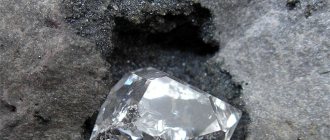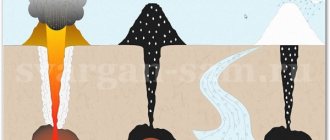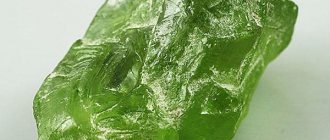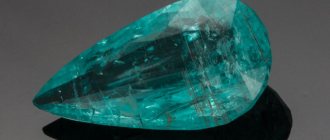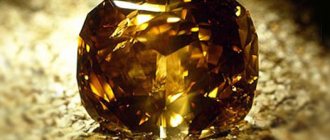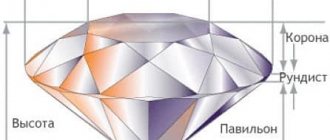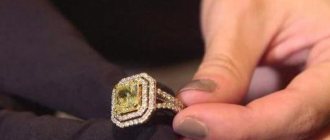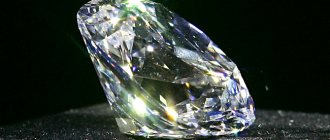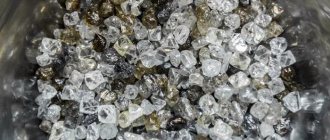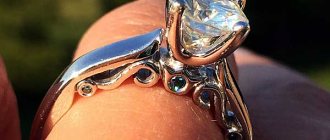People have always worshiped jewelry. Stones and metals not only conquered their minds, but also became the cause of wars. Some were ready to give their lives for them, while others were ready to take it away. Which jewels have almost always been the most valuable? Of course, it's gold and diamonds. They have even become a household name in their category. With gold, everything is more or less clear. It is mined, smelted, and so on, but what path does a diamond take from the first shovel stuck into the ground at the mine to the royal crown is a big question. Moreover, gold has always been mined in the same way, plus or minus, which cannot be said about diamonds. There really is room for improvement and development in terms of technology.
They are too beautiful not to be considered precious.
- 7.1 Diamond Kohinoor
Where do diamonds come from?
First, let's generally figure out where diamonds come from and how they appear in the depths of our planet. If you are already familiar with this or it is not very interesting to you, just scroll to the next point.
Diamond is the hardest mineral in the world . There is even a so-called Mohs scale, which is often used to determine the hardness of objects. Most often, recently, this scale can be encountered when determining the resistance of a smartphone screen to scratches. Without going into detail, it consists of 10 steps in which the hardness corresponds to the hardness of various substances - from talc to diamond. That is, diamond is considered the standard of hardness.
Diamond is a crystalline modification of pure carbon and is considered one of the most expensive stones. Transparent stones and those with a slight shade of blue are especially prized. The remaining impurities are considered defective, but sometimes they are also valued very highly.
The main places where diamonds are formed are areas of continents where no geological activity has occurred for a long time. This process occurs at great depths - approximately from 100 to 200 kilometers. This depth was chosen based on the conditions that are created there.
Man cannot create such beauty. Only nature is capable of this.
The temperature at such a depth reaches 1,500 degrees Celsius , and the pressure often exceeds 40,000 atmospheres . It is precisely this pressure and temperature that can change the crystalline structure of carbon so much that this stone turns out to be on the verge of fantasy.
Artificial diamonds have been produced in laboratories since the 60s of the last century. Recently, experiments have been carried out on the production of diamonds by creating pressure through a directed explosion. But all this is more reminiscent of some kind of alchemy. Although formally some insignificant diamond particles do form.
It must be said right away that no one goes to such depths to extract diamonds, since over billions of years they gradually come out on their own. They do this by being carried to the surface with kimberlite magma. This is how primary diamond deposits are formed.
And yet they are beautiful.
The definition of “kimberlite pipes” appeared after the first such pipe was discovered in the Kimberley province in southern Africa. They began to be called kimberlite, and the rock that contains diamonds was called kimberlite.
Now there are thousands of kimberlite pipes , but diamond mining is not profitable in all places. There are only a few dozen places in the world where it really makes sense to do this.
This is what a kimberlite pipe looks like.
What is a diamond?
This stone is a hard natural nugget. What gives it incredible strength is the crystal lattice, which looks like a cube. At its tops and inside there are carbon atoms. Having a strong connection with each other, they provide hardness to the stone. The density of diamond is maximum on the Mohs scale - it is 10 points.
Among the advantages of the mineral are the following:
- it is resistant to strong acids;
- melting temperature of the nugget is 3700–4000°C;
- The stone has a wide range of applications: jewelry, medical and electronic equipment, mining.
Diamond mining sites
Countries that have a lot of diamonds are very disparate in their level of economic development, social sphere, religion, and so on. However, they were lucky to be in the very places where diamond mining really makes sense.
Countries where diamonds are mined
- Russia - 40.32 million carats per year
- Congo - 23.20 million carats per year
- Botswana - 20.50 million carats per year
- Australia - 13.96 million carats per year
- Canada - 13.3 million carats per year
- Angola - 8.7 million carats per year
- South Africa - 8.3 million carats per year
Where are diamonds mined in Russia?
- Yakutia
- Arhangelsk region
- Murmansk region
- Karelia
- Perm region
Diamond deposits in Russia
Yakutia is considered the center for diamond production in the Russian Federation, where the most fertile kimberlite pipe is located. 97% of all stones are produced there. They are of high quality, so they are valued all over the world.
The largest kimberlite pipes in the Russian Federation:
- World;
- Zarnitsa;
- Successful;
- International
- Aikhal;
- Anniversary.
One of the first pipes found in Russia, Mir, was closed back in 2001, and now diamond production is carried out here only using the underground method. The same fate befell the International mine. According to geologists, the size of the deposit will allow uninterrupted diamond mining for another 25 years.
Diamond deposits were also found in the Urals and the Arkhangelsk region. Over the past 10 years, there has not been a single major discovery of deposits of precious stones in Russia, therefore, after the depletion of quarries, there is a constant search for new layers of kimberlite. The largest deposit in Arkhangelsk is named after the great scientist Lomonosov. Its potential is estimated at $14.3 billion.
How to find a diamond deposit
The diamond industry has one big problem. At one time, exploration of deposits was carried out in secret. That is why not all methods for determining their occurrence are still known. Of course, there are modern methods, but those who do this are still in no hurry to share their secrets, since there is a lot of money at stake.
The greatest likelihood of finding diamonds is in the area of volcanoes that have been extinct for a long time. It is there that a “natural laboratory” is often created, in which there will be all the conditions for growing these minerals and delivering them to the surface. Diamonds can also be found in the area of river beds that carry igneous rocks. Much attention should also be paid to meteorites, where diamonds are often found at their fall sites.
This formation of SU-30 and MiG-29 aerobatic teams is called the “Cuban Diamond” by Russian Knights and Swifts. The word “diamond” emphasizes the entire value of the figure.
First world diamonds
Even 7 thousand years ago, people learned about the existence of these stones. Placers were then discovered in India. The largest crystals were also found there. For thousands of years people have mined precious stones here. The most famous: “Shah”, “Kokhinur”, “Orlov”. In the 19th century, the deposits were deserted. Diamonds in India began to run out. Today, diamond mining in India continues, but they are mainly involved in cutting stones and selling diamonds.
By the time India lost ground, gems were found in South America. The first deposit in this country was discovered in the 18th century. The stones mined here are small, but of excellent quality. It is worth mentioning three of them: “Star of Egypt”, “Star of Minas”, “Star of the South”. They have amazing purity and shape. For a century, Brazil led the way in gem mining, but then new discoveries began and the time came for other giants in the diamond industry.
Unique finds were found in streams and rivers. Thus, the birthplace of the famous Eureka diamond weighing 11 carats is Africa; it was found in a riverbed. After this, South African deposits became popular.
How are diamonds mined?
The most difficult task in mining diamonds is that to obtain them you need to process tons of ore. It is usually believed that one ton of rock contains an average of 1-2 carats (0.2-0.4 grams) of diamonds, the size of which will further decrease during cutting.
Sometimes diamond mining is even possible by hand, and most often this method is available in Africa. But, as a rule, you have to work more thoroughly and carry out significantly larger-scale excavations. In general, the technology is somewhat reminiscent of gold panning, the only question is how many minerals are in the rock and over what area they are “scattered.”
It is from such a “hole in the ground” that diamonds are mined. Notice how much larger it is than the stadium.
The simplest and most inexpensive method of extraction is open-pit mining. First, the top layer of soil is removed, and then the quarry is gradually deepened by collapsing its walls with directed explosions. The rock is transported by quarry trucks to mining and processing plants (GOKs). This is where the ore is processed.
Craters often descend hundreds of meters deep into the earth, and their area is comparable to the area of small cities.
The second method is much more difficult to implement and is called closed. In this case, mines are drilled in which production is carried out. Firstly, you need to use sophisticated drilling equipment (as opposed to simple and relatively cheap explosions), and secondly, there is no such room for maneuver as when you simply “dig a hole” and remove the earth from it.
Mines are used in cases where it is impossible to use the open method for one reason or another. They drill to a depth of up to a kilometer (and sometimes more), after which the rock rises to the top and is also sent to mining and processing plants.
Such monsters transport ore to mining and processing plants.
When open-pit mining is no longer possible and the quarry cannot be expanded further, open-pit mining begins. The shafts are drilled vertically and inclined, and the step between them should not exceed one hundred meters. So the work continues as long as there is economic benefit.
Diamond mining work is carried out in three shifts of 7 hours each and never stops, and to ensure mining, mining towns with all the infrastructure are often built nearby, including hospitals, shops, sports facilities and even airports. Because often the only way to get to such places is by air.
To understand the size of a mining truck, you can show this photo. The truck simply did not notice and ran over the pickup.
Diamond cost
The final cost of diamonds mined from various deposits is influenced by a number of factors:
- deposit and profitability of crystal mining;
- production costs;
- global demand for products;
- quality of mined minerals.
The price of nuggets mined by developers is constantly changing, and such jumps occur weekly. However, average positions can be given using the exchange rate as a guide:
- The average quality of a diamond is estimated at 500 dollars or 30 thousand Russian rubles per carat. For 1 gram of product you need to pay up to 150 thousand rubles, 1 kg will cost 150 million rubles, including various commissions.
- Good quality crystals are valued from a thousand to one and a half thousand, if you take the cost in dollars.
- Single large specimens, the size of which starts from eight carats, are sold at prices exceeding twenty thousand US dollars per carat. It is necessary to understand that the estimated cost increases exponentially as the size of the stone increases.
Prices are given for minerals that are not cut. The price of faceted pieces is several times higher, since it takes into account the work of jewelry craftsmen. The cost is affected by the number of facets a stone has, the presence of small cracks after cutting and other factors.
How does a mining and processing plant work?
In order to process the rock and find diamonds in it, mining dump trucks transport thousands of tons of ore per day to special plants. There, the ore passes through various crushing and grinding systems. Often they differ from each other, but the whole point is to break the rock into small stones, then sift it by size in a screen (a special screening machine) and subject it to further processing.
Large pieces of rock are washed with water in order to obtain diamonds, and small pieces are exposed to special reagents that literally pull diamonds out of the rock. The spent rock undergoes additional testing - X-ray luminescence separation . The fact is that diamonds glow under X-rays. This property is used to check the quality of rock processing. The slightest flashes are detected automatically and part of the rock is blown off the belt. Then she is sent for additional testing.
The mining and processing plant is a huge structure with a bunch of specialized equipment.
When diamonds are collected, there are still impurities among them, and this is where manual labor begins. They are sorted by hand, removing even the slightest extra stones. After this, the diamonds are checked and sorted according to a huge number of parameters in order to be sent to special exchanges, where jewelers will buy them for further processing and use in jewelry.
Where are the most gems found?
The richest diamond deposits in the world are located in Russia. The top 10 largest quarries look like this:
- "Yubileiny", Russian Federation;
- “Udachny”, Russian Federation;
- "Mir", RF;
- Argyle, Australia;
- Catoca, Angola;
- "Venice", South Africa;
- them. V.P. Grib, RF;
- "Jwaneng", Botswana;
- Orapa, Botswana;
- "Botoubinskaya", Russian Federation.
As you can see, our country takes the first three places. If we look for mines on maps, we will see that most are located in Yakutia.
If we talk about the volumes of crystals found, diamond production is distributed differently across countries. So, the leading countries in diamond mining are:
- Botswana;
- Russia;
- Canada;
- SOUTH AFRICA;
- Angola.
Here the ranking is headed by Africa.
The largest deposits on the planet, the extraction of stones, and their turnover are controlled by several large companies and international corporations. Some own mines in different parts of the Earth. Three leading companies can be noted: De Beers (South Africa), BHP Billton (Australia) and the Russian ALKOROSA.
How is a diamond different from a diamond?
Many people confuse these two words, but they are what distinguish the mined mineral from the finished piece of jewelry. The moment a mineral is in the ground, in the back of a mining truck, or in a warehouse awaiting cutting, it is a diamond. Once it is processed, it becomes a diamond.
Few people know, but diamonds can be broken if you hit them very hard. They split into pieces along planes parallel to the faces of a regular octahedron. This is exactly the structure it has. Roughly speaking, it is splitting “at the seams.”
The word diamond translated from French “brilliant” means “brilliant”. This is exactly what it becomes after processing, and the processing itself involves applying 57 or 58 facets to the surface of the stone. They refract light and give the stone that very radiance for which it is so valued.
On the left is a diamond, on the right is a diamond. There is a difference, right?
About 75 percent of diamonds sold in the world are classically cut. This form consists of the following elements:
- Crown (top)
- Girdle (widest part)
- Pavilion (lower part)
Despite the fact that the diamond itself will be beautiful even with cutting defects, and only a specialist can recognize the defect, a special technique is used here. Craftsmen have been studying how to cut diamonds correctly for many years, and they must observe the cut proportions as correctly as possible.
If the cut is made other than the classic or fancy shape, it is divided into two types. Without going into detail, this is a shape closer to round or, conversely, closer to an elongated shape.
How to distinguish real from fake?
The authenticity of a diamond can be determined in different ways. Some can be used independently, others require the intervention of a specialist. The following recommendations will help you distinguish a diamond from a fake:
- A real crystal is never framed in silver or other cheap metal. A similar mineral in jewelry is presented only in combination with expensive metals - platinum or gold.
- If the stone has a flat and smooth surface without the presence of cracks or other defects, this indicates that this is a fake that shines and shines beautifully.
- Real specimens are not translucent. If you can read words through the nugget, it’s a fake.
- Diamonds have enormous density. It is necessary to move the stone along the glass, pressing it lightly. The natural mineral will certainly leave a scratch on the glass.
- Faceted stones have a bright shine and play with light. Compared to this radiance, other minerals look dull and pale, even if they have a high-quality cut. Diamond has a high refractive index. Thanks to this, it sparkles strongly in the light.
- Real diamonds never fog up. To check this property, you need to wipe the crystal with a dry flannel cloth and breathe on it for a few seconds. If you have a fake in your hands, then evaporation will form on its surface, the diamond will remain dry.
- Due to their transparency, genuine crystals are not visible in water. By immersing diamond jewelry in liquid, you can quickly determine the authenticity of the nugget.
- Lightly coat the real diamond with vegetable oil, then press it against the glass. You will notice that it sticks to it.
- You can use an ultraviolet lamp to check. It is necessary to illuminate the mineral with rays. If the crystal glows with a bluish tint, then it is 99.9% a natural diamond. If a yellow or green color is present, a synthetic cut or other material may be suspected.
The most famous diamonds
Diamond Kohinoor
the most famous diamond today is the Kohinoor. In Farsi it means “Mountain of Light”. Legend has it that its first owner was a boy who appeared several thousand years before the birth of Christ near the Yamuna River. This was not an ordinary child, but a product of the Sun-Karna. The stone was an ornament to his embroidered cap.
It is “Kohinoor” that is the “prima” of the British crown.
Over its history, the stone has seen a lot of blood and changed its owner until it became part of the English crown. Now it is in the Tower Castle and is securely guarded. Many say that the only worthy price for this stone is the life of the one who wants to get it.
You can learn even more about what surrounds us and about the unusual side of our lives from our Telegram channel. Interesting facts and scientific humor appear there every day.
Diamond "Tiffany"
In 1877, a diamond was found in Kimberley, which became the world's largest yellow diamond. It weighed 287 carats and was sold for $18,000—unheard of money at that time. Charles Tiffany stone . The cutting took almost two years, and as a result the stone took on a quadrangular shape and shone with 89 facets.
The unusual cut of this diamond makes it very interesting.
As a result, the stone decorated the window of a store on Fifth Avenue in New York. The first person who was able to feel it on her body was the star of the movie “Breakfast at Tiffany’s” Audrey Hepburn. After that, a diamond with an unusual cut and a setting in the shape of a diamond bird went to auction, but was never sold. As a result, it became the symbol of the Tiffany&Co store.
Diamond "Black Orlov"
Another world-famous diamond is called “Black Orlov” . Initially, he was buried in one of the Indian tombs, but robbers were able to kidnap him. As a result, as the legend goes, they brought a curse on themselves and on everyone into whose hands the stone fell.
The same “Black Orlov”...
Countess Nadezhda Orlova and Princess Golitsyna are attributed to the victims of the stone. It is also customary to attribute Jay Paris to the victims, who wanted to sell the stone in New York, but for some reason jumped off the roof instead.
There are other famous diamonds that have caused a lot of problems for their owners. And all because there is a lot of money behind them, a symbol of power and simply a charming shine that “blows the roof off.” There is no need to give them a mystical meaning; it is enough to simply understand human greed and the desire for easy money, perhaps even at the cost of someone else’s life.
Diamonds in nature
In the upper mantle of the Earth, at a depth of more than 100-150 km, under the influence of high temperatures and enormous pressure, pure carbon atoms from the graphite state are modified into crystals, which we call diamonds. This crystallization process takes hundreds of years. After spending several million years in its depths, diamonds are brought to the surface of the earth by kimberlite magma during volcanic explosions. With such an explosion, so-called pipes are formed - kimberlite diamond deposits. The name “kimberlite” comes from the African town of Kimberley, in the area of which diamond-bearing rock was discovered. Nowadays, there are two types of diamond deposits: primary (lamproite and kimberlite) and secondary (placers).
Diamonds were known to mankind three thousand years before our era; the first mentions of them were found in India. People immediately endowed diamond with supernatural properties, thanks to its indestructible hardness, brilliance and transparent purity. It was accessible only to selected persons who had power and authority.
South Africa
South Africa is the most developed country on the African continent, the undoubted leader in the number of mineral deposits, including diamonds. The only country in Africa that is not a third world country. The constant growth of GDP marks the incredible activity of the country's foreign market. South Africa ranks fifth in annual diamond production ( 7.4 million carats - $1.22 billion )
Botswana
Botswana, a country located in the south of the African continent, boasts the largest number of diamond mines. It borders South Africa, Namibia and Zambia. More than 70% of this country is occupied by the Kalahari Desert, the so-called “green desert”.
The country is one of the recognized leaders in the production and value of all diamonds. Industrial mining of these stones in the country began back in 1971. In addition, Botswana has rich deposits of gold, silver and platinum. The main share of the state's export products comes from the USA and Western Europe. 24.6 million carats per year,
Angola
Angola ranks fourth in the world in diamond production. The main deposit is Fukauma. Angola's economy is mainly based on the production and sale of oil. It is thanks to oil exports that the country's economy is developing very quickly among all sub-Saharan African countries.
Since diamond production is calculated not by mass (kg), but by their value. The value is determined by the size and purity of the stones. Then Angola produces 8.7 million carats of diamonds worth 1.32 billion dollars .
Russia
Russia is one of the world's largest owners of almost all types of minerals. The country has rich deposits of ferrous and non-ferrous metals, coal, oil, and natural gas. Many of the natural resources presented are located in Siberia, including the richest kimberlite pipes.
For a very long time, Russia was not considered a diamond-mining country, although at the end of the 19th century small diamond deposits were discovered in the Urals. But the vast territorial expanses of our country did not allow the hope of discovering new deposits to fade, and, according to scientists, it was in Yakutia. The largest diamond deposits are located in the Sakha Republic, Arkhangelsk and Perm regions. In 2007-2008, Russia occupied a leading position in the ranking of diamond production. Today, the Russian Federation has first place in the world in diamond production ( 38.3 million carats, worth $3.73 billion )
